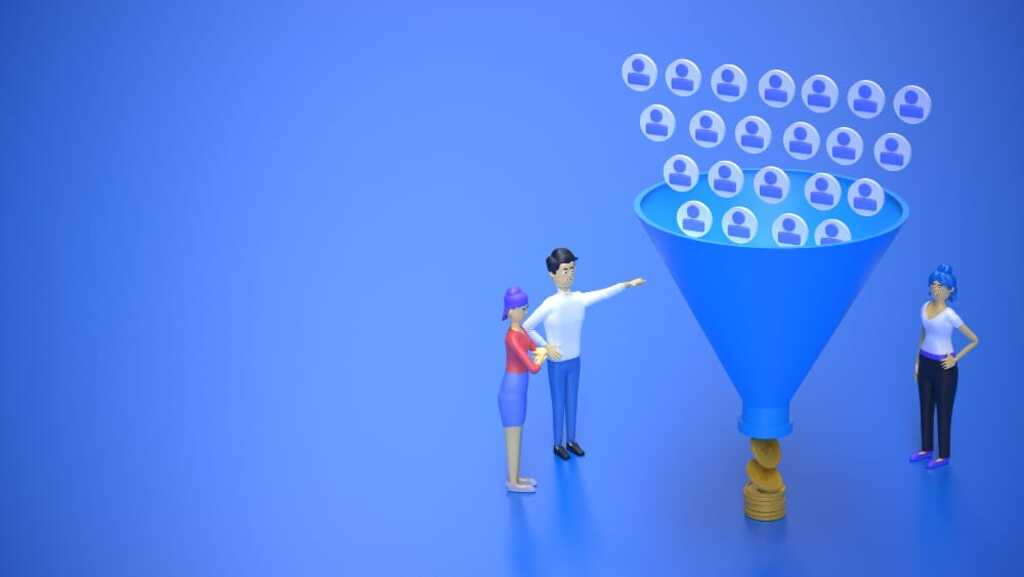You’ve certainly heard of a sales funnel and know how important representation is for business. After all, it simply illustrates how a customer’s journey works, helping to develop strategies. There are numerous ways to present it, each with a more specific focus. And, in this article, we’re going to cover the 7 stages of the sales funnel, with an eye on what’s most modern in business strategy.
Over the years, the sales process, the customer journey and the way marketing relates to our daily lives have changed a lot.
Philip Kotler – about whom we will talk at the end of this text – is a pope on the subject and adamant: the time when the idea was to sell to the masses is gone. Businesses today need to be customizable, and the 7 stages of the sales funnel that we are going to cover are exactly about that.
Mapa do Conteúdo:
ToggleHow are sales made today?
Until recently, companies sought to sell in the same way to as many customers as possible. It happens, however, that there was a great diversification of players in the market, specific niches were created and, today, small ones are able to compete with the big ones many times under similar conditions.
Thus, the way of negotiating had to evolve, and nowadays one of the most accepted strategies is what is conventionally calledconsultative sales. The term emerged about half a century ago, but it has only recently become common practice in business.
The central idea behind consultative sales is to make the seller become, in fact, a business partner.
When working with consultative sales, the consultant analyzes the difficulties faced by the company with which he is negotiating, and what are the alternatives to overcome them. It is only from there that he draws a sales proposal.
By doing this, sellers tend to make more assertive proposals for customers. Thus, the chances of the solutions being effective are greater, the customer experience improves and the chance of doing future business also increases.
Consultative sales usually bring a series of advantages, and in corporate businesses the most obvious one is the increase in the average ticket. After all, sales in B2B environments naturally tend to involve larger sums, and companies that feel secure in negotiating with others tend to spend more.
It so happens that, although in consultative sales the way of acting is different from that seen as traditional in the past, many things are similar. One is that all negotiations go through stages. And do you know the stages of the sales process?
7 stages of the sales funnel
In this model, the journey has seven steps. And the 7 stages of the sales process are divided in very different ways, with the intention of seeking the best leads from the beginning.
Therefore, the first of the sales stages (prospecting and qualification) is of paramount importance for the smooth running of the entire journey. After all, a bad choice about who to negotiate with can mean unnecessary expenditure of resources, as well as an effective loss of time.
It is clear, however, that all stages deserve the utmost attention. Knowing how to prepare a presentation that fits the potential customer, choosing the best way to approach them and presenting a proposal that fits their needs is the first part of a successful sales process. The final part, in turn, is about being as consultative as possible.
- That said, these are the 7 stages of the sales funnel:
- Prospecting and qualification;
- Preparation;
- Approach;
- Presentation;
- Dealing with objections;
- Closure;
- Follow-up and loyalty.

1. Prospecting and qualification
Let’s start at the beginning. The first step in an effective sales process is prospecting. In it, you make widemarket research after potential customers – which in marketing and sales are conventionally called leads.
There are several ways to do this prospecting, both through inbound marketing,how much per active search.
In case of corporate business, the intention behind the prospecting process is to have a broad base of potential customers. These are companies that are in a branch of economic activity similar to yours or capable of being interested in your product or service.
This initial search should be broad. Any and all companies that seem to benefit from the products or services you have to offer need to get on your radar.
It happens, however, that not all of them will actually become customers. Therefore, to reduce the chance of error by investing in negotiations that have no chance of occurring – at least at that moment – it is necessary to qualify the leads.
A lead qualification it is the sales stage in which you analyze whether that company can, in fact, move forward in a negotiation.
At that moment, you need to find out if that lead is ready, willing and, above all, able to buy from you. After all, there is no point in spending weeks or even months negotiating – something quite common in the stages of thecomplex sales process, for example – if that company does not have effective conditions to make a purchase.
Qualification is very important because it is also a statistical issue. Studies have already shown that, in modern sales, in general, a typical purchase happens after approaching seven potential customers. Thus, it is essential to find the leads that best fit theideal customer profile before moving on to the next stage of the sales funnel.
Do you want to grow your business with the help of B2B experts? Protagnst can help! Get in touch and find out about our solutions.
2. Preparation
The second of the 7 stages of the sales process also precedes the approach itself. In other words, you have to do your homework.
You have already identified a company that could be a potential customer. You’ve already warmed up that lead, identifying that he has a real chance of being interested in your product or service. The business is indeed promising. That way, you can’t afford not to be properly ready to present your solution to him.
The preparation stage is more research. This time, however, you need to scour the market for solutions that resemble your own. Competition costs, advantages and disadvantages.
In addition, of course, you should surround yourself with as much information about your potential client as possible. Areas of activity, productive capacity, growth trend and so on.
This step in the sales process is important because once you gather all that information, you can start customizing a deal unique to that lead. In other words, something that fits your needs and pains perfectly. A proposal that will actually help that company to achieve its goals.
As mentioned earlier, this is the essence of consultative selling. It is a purpose to be sought and a direction to always follow.
3. Approach
If the homework was done correctly, we reached the approach stage, the third of our 7 stages of the sales funnel.
There are different ways of doing the first approach, and choosing the right one is essential to have better business chances.
When we talk about B2B sales, we are referring to people who tend to be extremely busy. These are managers who have to work hard with meetings, travel, contracts to review, and so on. And, after all, each person relates to their demands differently.
Some prefer phone contacts. Others work best via email or WhatsApp message. Nowadays, there are those who prefer to do business even through LinkedIn, due to the ease of access to professional information. And there are those who only negotiate in person.
As you can see, making phone contact with a lead who only works through internet resources is a very bad idea. After all, as cliché as it may be, the first impression is usually the one that lasts.
It’s also a bad idea to knock on someone’s door for a face-to-face meeting if the advance preparation falls short of what is expected. So, if possible, try to talk to people who know how your lead acts.
That done, after defining the best way to approach, start the relationship. The first conversation should be smooth. Comment on your product, interact, ask warm-up questions, talk about the company you represent.
Depending on the case, and if it’s feasible, it’s worth sending a free sample of the product or service you want to present as a solution.

4. Presentation
This is the stage of the sales funnel where you actually present your solution to the potential customer. The presentation must be succinct and complete at the same time, so as not to bore the lead, nor to appear shallow.
Use a slideshow or other technological resource that facilitates the visualization of your product or service. Videos, images or quotes from successful cases are good options.
Keep in mind that it is essential to awaken his interaction. Listening, at this stage, is even more important than talking. After all, it’s the best way for you to further customize the business for that company.
Also consider that there is always the possibility that you are not the only salesperson trying to do business with that company. The lead can follow your offer while associating it with your competitor’s.
If you notice something along these lines, it is also in the presentation that you should offer extra business opportunities, such asup sell e cross sell, or any other viable sales strategy. This, however, must be done within very specific parameters that can actually improve the customer experience.
If it is already difficult to negotiate a solution that will clearly be useful to him, “pushing” a product or service that does not meet his needs can cause a breach of trust and increase objections with the business.
5. Dealing with objections
You already know what thesales objections, Is not it? They are those difficulties or barriers that potential customers have during a negotiation. And, if you don’t work around them properly, they can simply make the sale fall apart.
Here it is necessary to be very clear: objections are among the most underestimated stages of the sales and customer relationship process, which is a tremendous mistake on the part of sellers – and this does not depend on the path you will take.
Studies have already shown that 44% of consultants or sales representatives leave the business after a single rejection; nearly a quarter of them (22%) do so after two rejections; 14% leave the business after three, and 12% after four.
If easily walking out of the deal is a mistake, ignoring objections is an even bigger mistake.
Keep in mind that objections are common, and you need to prepare for them. A good seller is one who knows that the potential customer may raise doubts, questions and impose some difficulties to close a purchase.
Sales objections don’t mean the lead won’t buy. It means that you, as a seller, will need to give more arguments to convince him.
First of all, acknowledge that the lead is correct with their concerns. Show empathy. Ask questions that encourage you to share your fears.
Then reassure him with the correct answers.
Obviously, to do this, you need to prepare. The best way is to pre-map all possible objections. And if one comes up that you don’t know how to solve at the moment, say that you will evaluate it with your team and present a solution as soon as possible.

6. Closing
This is the most awaited sales step. It is at this time that the potential customer will either agree with your offer or decline it.
If your client is willing to purchase your product or service, it’s time for you to make his job easier. Offer payment alternatives – in cash or in installments, by transfer or other means. Also take care of the bureaucratic part, leaving the contract ready and taking care of all procedures.
In case the customer is still having doubts, however, offer an extra incentive. If you work with services, for example, offer a free extra term. If possible, allow the payment to start a little later than anticipated.
In short, demonstrate that you really want to become his business partner and that, in order to do so, you are willing to make one last concession – provided that this does not result in losses for you, of course.
Another way of trying to secure closure is by launching one of the famous mental triggers – and thescarcity trigger is often quite useful in corporate sales. “It’s our last batch in stock”, “we only have so many licenses for use”, “I can only keep the values in these terms that we negotiate until next week” are some examples.
7. Monitoring and loyalty
Follow-up completes the 7 Kotler sales steps. It is the after-sales phase, which is fundamental for customer loyalty.
Very common examples of effective follow-ups are those of electronics companies. Dell, for example, became famous a few decades ago for its after-sales efficiency.
As soon as the computer company settled in Brazil, notebooks were only sold by order directly from the factory. The computer was then taken to the customer by a company representative.
The equipment came out with a unique service tag, which meant that whatever the problem was could be solved with a single call – after all, Dell knew exactly which computer it was.
Such efficiency created a generation of loyal customers for the company, who didn’t mind paying more for the product knowing that they would have easy support at any time.
In corporate business, making yourself available to customers is essential to provide them with security. More than that, it allows you to develop a greater level of trust, which will give that company a great chance of doing business with you again.
Do you want qualified leads that have a good chance of advancing down your sales funnel? Count on the help of Protagnst experts. Get in touch today and see how we can help.

How did the 7 stages of the sales funnel come about?
As we mentioned earlier, the way of doing business has evolved over the decades, especially in recent years.
In the past, traditional marketing prevailed, that of active search. Advertisements in newspapers and magazines, commercials on radio and TV, as well as advertising on billboards, were the conventional ways of getting to know a company or product.
With the arrival of the internet and the advent of social networks, however, access to new markets has become an endless possibility. In addition to companies being able to invest ininbound marketing – much cheaper and with the potential to bring customers to them -, consumers themselves can look for business opportunities.
Thus, the task of prospecting, validating and presenting itself as a solution to customer pain has become an even greater challenge.
Marketing guru, Philip Kotler has been studying these movements since the middle of the last century, and he always reiterates the importance of focusing on the customer.
Who is Phillip Kotler?
Born 90 years ago, Philip Kotler is still one of the world’s greatest references in marketing. He holds a PhD in economics from the prestigious Massachusetts Institute of Technology (MIT) and is also a postdoc in mathematics from Harvard University and in behavioral sciences from the University of Chicago.
He developed the thesis that marketing is very strongly linked to the economy, and not just to price. It was with this thought that he revolutionized marketing strategies – and still does today.
For the professor, marketing is both an administrative and a social process. It is this process that makes people obtain what they want and need through the generation of desire, offering and exchanging products of value.
Through his teachings, which accompanied the evolution and changes over the decades, new business strategies were developed, which helped to create Kotler’s sales stages and the stages of the sales funnel in digital marketing.
About the sales funnel
In addition to this article, here at Protagnst we have already presentedthe sales funnel in several others. However, this is not about redundancy; it is, indeed, something fundamental in business. And Kotler has a theory as well about its use and evolution.
As you know, there are several representations of the sales funnel, some focusing more on marketing, others more on sales. Philip Kotler, in turn, considers that the stages of the sales funnel in digital marketing need to operate at very specific times.
If we divide our funnel into three parts, we will have at the top of the funnel the moment of learning and discovery, the one in which the lead discovers you; in the middle of the funnel the phase in which he recognizes that he has a problem and that you have a possible solution; and at the bottom is where you close the sale.
Now, it is also possible to divide the funnel into six parts:
1) customer prospecting;
2) understanding of the needs of the target audience;
3) development of solutions;
4) proposal presentation;
5) contract negotiation;
6) sale.
For Kotler, the first three steps should be under the responsibility of the marketing team, while the last three should be left to the sales team. For him, after all, when doing this, each part will be with those who actually understand the subject.
Final considerations
Although there are differences in the numbers, different studies converge on one point: it is much more difficult to win a customer than to retain it. And this in corporate business is especially true.
In everyday life, it is very easy to switch brands. You may be in the habit of buying a certain type of coffee, for example, but you probably won’t have a problem trying another brand if your favorite brand is out of stock or the current price is an impediment.
In intercompany business, however, this is more difficult. Transactions involve high amounts, and any mistake can represent an unavoidable hole for the company’s future. Thus, they usually give preference to businesses with whom they already know.
This is why following the 7 stages of the sales funnel is often a good choice. After all, they teach that, with good planning and correct execution, the result is good sales and customer loyalty.




